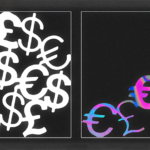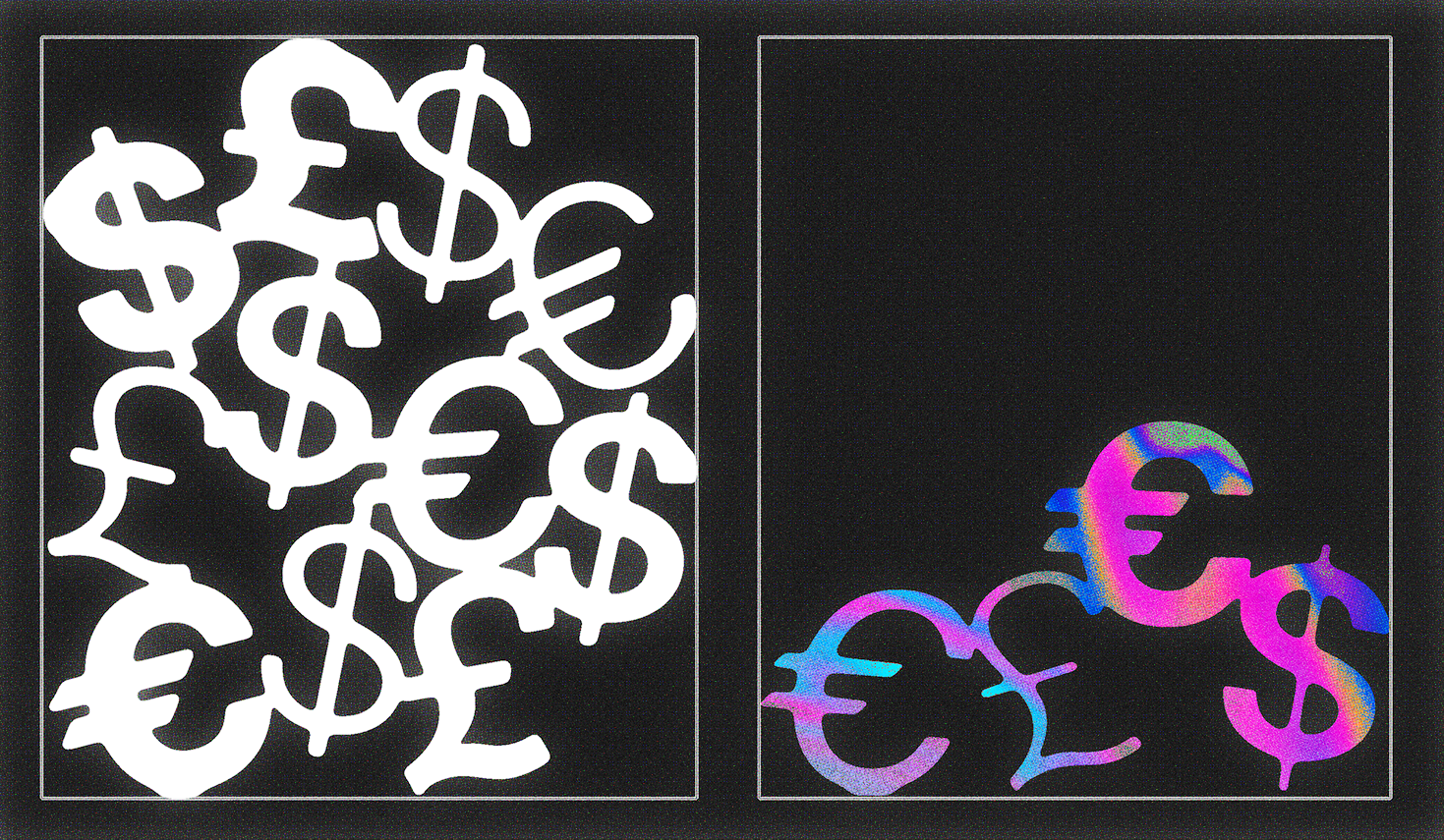
LGBTQIA+ employees are often paid less than their straight counterparts, data shows. What can we do to close the gap?
WORDS BY NICOLE GARCÍA MÉRIDA
HEADER BY YOSEF PHELAN

Minorities never really need to look at data to confirm they’re being discriminated against. We see it, we feel it, we experience it in the flesh — yet several studies have demonstrated the existence of an LGBTQIA+ wage gap.
A survey carried out by YouGov in 2019, commissioned by LinkedIn and UK Black Pride, found that LGBTQIA+ people in the UK earn around £7,000 less than their straight counterparts. In his 2022 paper, Professor Nick Drydakis from Anglia Ruskin University found that gay men’s earnings were 6.8% lower than those of comparable straight men, while bisexual men’s earnings were 10.3% lower than those of heterosexual men.
Separately in the US, an HRC Foundation analysis conducted in 2022 of nearly 7,000 full-time LGBTQ+ found LGBTQIA+ workers earn around 90 cents to the dollar that every straight person earns. The gap widens for LGBTQIA+ people of colour, trans people and non-binary people.
Data also shows that workplaces are not well equipped to close the gap. A poll of around 1,000 HR managers from the Trades Unions Congress (TUC) revealed one in five workplaces don’t have any policies in place to support their LGBTQ+ staff. And concerningly, data collected by UK charity Just Like Us showed that a quarter of young LGBTQIA+ adults went back in the closet when they started work.
How can we report on the wage gap?
Despite the number of studies that have been conducted on earnings discrepancies, there’s a long way to go when it comes to data reporting. While gender wage gap reporting is mandatory in the UK for companies with 250 or more employees, employers are not required to collect or report information on ethnicity wage gaps or LGBTQIA+ wage gaps.
“One of our big asks is that the government include us in the big statistical surveys so we understand what is happening to the community at a national level on a statistical level,” said Quinn Roache, policy officer at Trades Union Congress.
“But I worry a lot that when we start getting the data at a national level or employers are getting the data, that it won’t be right… If we get pay gap reporting for LGBTQ+ issues, and we have employers saying they have no pay gap, I would say let’s look at your data. Are you only surveying employees in the top roles? I would say what you have is a monitoring issue in terms of the quality of groupings.”
While gender wage gap reporting is mandatory in the UK for companies with 250 or more employees, employers are not required to collect or report information on ethnicity wage gaps or LGBTQ+ wage gaps.
TUC has found only one in eight employees monitor the LGBTQIA+ pay gap. Ken Janssens, co-founder of Windō, a platform that compares organisations diversity, equity and inclusion progress, notes that when companies report on the sexual orientation pay gap, they report on the L, G and the B in LGBTQ+ – not the Q and not the T. Currently, only 15 companies voluntarily share their sexual orientation pay gap data, and the average gap is 8.8%.
Even when companies are reporting this data, it’s important to keep certain factors in mind such as visibility and data inclusion. “It’s important that companies share how many employees have participated in [self-identification],” says Janssens. The data won’t really start feeling representative when reporting is at around 80% or 90% participation.
The data may also show certain discrepancies. In his study, Professor Drydakis found that lesbian women’s earnings were 7.1% higher than those of comparable heterosexual women. This “presents a puzzling issue,” he says, but there could be many reasons for this.
“A peripheral explanation for the lesbian earnings premium may revolve around women with children earning less than those without children,” Professor Drydakis says. “Additionally, lesbian women might demonstrate greater dedication to the labour market as they are less likely to rely on a higher-earning (male) partner for financial support, potentially leading them to invest more in their careers.”
What is driving the gender pay gap?
“The labour market penalties faced by gay men are likely linked to firms’ negative attitudes towards minority populations,” says Professor Drydakis. “Biases may also arise if organisations use sexual orientation to infer job-related characteristics, productivity, and commitment.
“If gay men do not conform to traditional gender roles associated with masculinity and leadership, this could lead to unfavourable evaluations and earnings penalties. To mitigate these biases, organisations should invest more resources in verifying employees’ qualifications.”
“If someone is working in an environment where they’re not necessarily able to be themselves completely, maybe even hiding that part about their identity, they’re driving energy into that,” says Janssens. “I worked at JPMorgan for 25 years… and I wasn’t out to work for the first three. I know what that was like.”
“When people ask you, how was your weekend? That would be the question I would dread because I would have to lie, and people can detect that,” he continues. “So they kind of go, there’s something funny about you. And when people think there’s something funny, then, you might not be given the promotion, the opportunity, the project.”
Ultimately, the pay gap is reflective of poor treatment, says Roache, and intersectionality plays a huge role. “If you’re LGBTQ+ and disabled, you already know there’s a disability pay gap, there’s also a race pay gap, you could be experiencing a double pay gap. And let’s not forget there’s a gender pay gap,” he says.
A survey carried out by myGwork, a business community for LGBTQIA+ professionals, found eight out of 10 LGBTQIA+ women and non-binary professionals across all age groups find it tougher to shatter the glass ceiling than heterosexual cisgender women. “This challenge is even greater for those with intersectional identities, especially those from Latinx, South Asian, Middle Eastern, East Asian, and Black/African communities, who reported finding it particularly challenging compared to their white colleagues,” says Adrien and Pierre Gaubert, Co-founders of myGwork.
What can we do about the pay gap?
It’s important the government starts mandating this data be reported because this will give a more complete picture of the difficulties LGBTQIA+ people are facing in achieving equal pay. While data may be up for scrutiny, all the studies agree on one thing – LGBTQIA+ people are being paid less.
The government also needs to change its anti-”woke” anti-DEI positioning, Janssens points out. “That is doing real damage. It’s making LBTQ+ people fearful, and it has an impact on the workplace as well… all the anti-trans rhetoric is probably the worst in that,” he says.
Additionally, a lot of the responsibility also falls on employers. “They need to put a lot of time and energy into how they’re going to collect monitoring data from their employees because [employees] need to know there isn’t going to be a negative consequence to ticking that box,” says Roache.
[Employers] need to put a lot of time and energy into how they’re going to collect monitoring data from their employees because [employees] need to know there isn’t going to be a negative consequence to ticking that box
“And if they have a gap they need to look at where their lgbt workers are in the organisation, and […] look at where they are to make sure LGBTQ+ people who come into the workforce are able to bring their authentic selves and have access to training and promotions and that there aren’t any intentional or unintentional boundaries that are stopping the LGBTQIA+ community from accessing these things,” he adds.
Roache stresses the importance of joining a union. Research from TUC shows that LGBTQIA+ people who join their union are more likely to speak up when they have been discriminated against. “Get involved in collective bargaining and ensure your union is asking for LGBTQ+ workers to get access to training and development and to make sure there are no barriers preventing them from progressing,” Roache says. “As an individual you’re limited but as a collective, you have more strength and power.”
Read more of GAY TIMES’ finance coverage and deep dives here.
The post What is the LGBTQ+ wage gap, and how can we fight it? appeared first on GAY TIMES.

0 Comments